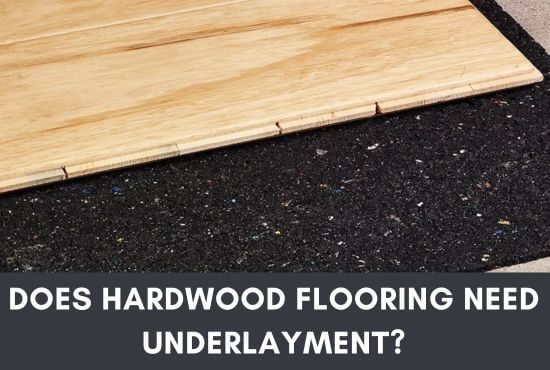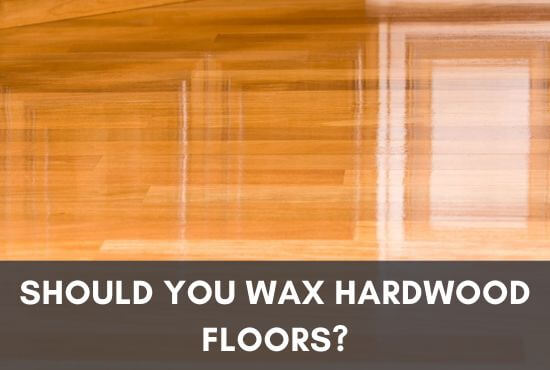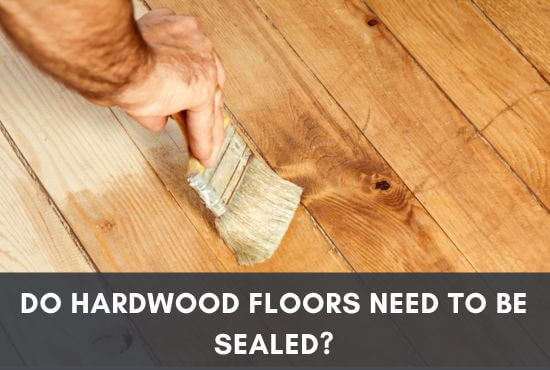Installing a hardwood floor is a delightful upgrade that brings warmth and elegance to your home. But it’s necessary to install a shield the protects your floor from moisture and other damages. This is where moisture barrier comes in.
You must install a moisture barrier to protect your wood floors and sub-floors from water damage. It blocks moisture, maintaining the floor’s integrity, especially in humid areas or over concrete sub-floors. The choice of barrier depends on your sub-floor type and installation method.

This guide dives into the essence of a moisture barrier for your wood floors, helping you make an informed decision for your flooring project.
Table of Contents
What Is A Moisture Barrier?

A moisture barrier is a layer placed between your hardwood floor and the subfloor to prevent moisture from seeping through and causing damage such as warping, cupping, or even mildew growth.
It’s like giving your floor a shield against unwanted water intrusion.
Ensure a dry foundation for your hardwood floors with a sump pump in your crawl space.. Get the installation guide to safeguard your flooring investment.
Moisture Barrier Prevents Water Damage
A moisture barrier acts as a defensive shield, blocking any moisture from reaching the delicate wood of your flooring from below. This is particularly beneficial in areas prone to high humidity or unexpected water spills that cause bouncy or vibrating floors.
By keeping the moisture at bay, this barrier ensures that the aesthetic and structural integrity of your wood floor isn’t compromised.
Over time, this protection against water damage proves to be a cost-effective solution, saving you from potential expensive repairs or replacements.
Moisture Barrier Maintains Floor Integrity
The charm of a hardwood floor lies in its smooth finish, warm tones, and durable nature. A moisture barrier plays a pivotal role in maintaining these qualities.
By preventing moisture-induced warping or cupping, the barrier helps keep your floor looking and functioning as intended.
Moreover, it contributes to a healthier home environment by preventing the growth of mildew, a common issue associated with moisture seepage.
The consistent protection offered by a moisture barrier ensures your hardwood floor continues to add value and comfort to your home over the years.
Why Moisture Barriers For Wood Flooring And Sub-flooring Are Essential?

Installing hardwood floors on or below ground level, especially on concrete slabs, exposes them to moisture risks. Here’s why having a moisture barrier is a wise choice:
Long-term Protection
A moisture barrier is like a shield for your hardwood floor against water and dampness.
Over time, it keeps your floor looking good and staying strong by stopping water from getting through, which could cause the wood to swell or get moldy.
It’s a small step you take that helps your floor stay beautiful and sturdy for a longer time.
However, it’s important to note that sometimes, a moisture barrier may not be recommended.
Particularly, if you’re installing hardwood floors over a wood subfloor, it’s advised to avoid using a moisture barrier.
Over time, moisture can become trapped between the moisture barrier protecting your hardwood flooring and the wood subfloor, which can lead to the subfloor warping and rotting.
This promotes mold growth and can cause serious damage to your home.
Hence, understanding the type of subfloor you have is crucial before deciding on the installation of a moisture barrier.
A french drain system is a protector against crawl space moisture. Learn how it saves your hardwood floor from water damage.
Warranty Compliance
When you buy hardwood floors, they often come with a warranty from the manufacturer. But to keep this warranty valid, many manufacturers ask that you install a moisture barrier.
This way, if something goes wrong with the flooring, you can get it fixed under warranty since you followed their guidelines.
So, a moisture barrier not only protects your floor but keeps your warranty in check too.
Enhanced Resale Value
When your floor is well-protected and stays in good shape for a long time, your house’s value can go up if you decide to sell it.
People buying houses love to see well-kept hardwood floors, and knowing there’s a moisture barrier protecting it can be a plus.
So, a moisture barrier can help make your home a better buy for others.
Cost-Efficiency
Putting in a moisture barrier can save you money in the long run. Fixing or replacing hardwood floors can cost a lot, but a moisture barrier helps you avoid these costs by stopping water damage before it starts.
It’s a smart way to save money while keeping your floor looking great.
Health Benefits
A moisture barrier helps keep your floor dry, which is good for your health. Wet or damp floors can grow mold and mildew, which can be bad for people with allergies.
A moisture barrier stops the wetness from getting through, helping to keep the air in your home cleaner and healthier for everyone.
Types of Moisture Barriers
There are several moisture barrier options to choose from, each suitable for different installation scenarios.
Plastic Sheeting
Plastic sheeting is a common and easy-to-use moisture barrier.
It comes in rolls, just like wrapping paper, and you unroll it onto the floor before laying down your hardwood. It acts like a plastic shield, stopping water from getting to your wood.
When it came to laying down hardwood in my workshop, creating a moisture barrier was a top priority to prevent any water damage.
The Farm black plastic sheeting was my go-to choice – its 10 mil thickness provided an impressive shield, and unrolling it onto the floor was a straightforward task. The sizeable 10′ x 100′ roll was ample for my space, and its durability immediately stood out.

Cutting it to fit was a breeze, and I could feel the quality with every snip. I wholeheartedly recommend this sheeting; it’s a budget-friendly investment for the long-term safety of your flooring.
It’s a straightforward and budget-friendly option that works well in many situations. You just cut it to fit your space, lay it down, and you’ve got a layer of protection against moisture.
Ease your crawl space maintenance with a well-installed access door. Dive into the installation guide to prolong your hardwood floor’s lifespan.
Liquid Solutions
Liquid solutions are like paint that blocks water. You can brush them on, roll them on with a paint roller, or spread them with a trowel, which is a flat tool used to spread substances smoothly.
I opted for USG DUROCK Liquid Waterproofing Membrane due to its ease of application and robust water-blocking capability.

Unlike plastic sheeting, which can be a bit tedious to cut and lay down precisely, the liquid solution was a breeze to apply with a paint roller, providing a seamless and secure barrier against moisture.
Once it dries, it forms a hard shield on top of the subfloor to keep water away from your hardwood floor.
It’s a good choice if you want something that sticks to the floor and creates a tough barrier against moisture. Though it might need a bit of time to dry, it’s a strong protector once set.
Barrier and Underlayment Combos
Barrier and underlayment combos are like two-in-one solutions. Not only do they stop water from reaching your wood floor, but they also add a soft layer that makes your floor quieter and more comfortable to walk on.
They come in rolls, and you lay them down just like the plastic sheeting. But they are thicker and softer.
It’s like adding a cozy rug between your subfloor and your hardwood floor that also keeps water away.
One option that I would recommend for this is Premium 2-in-1 Underlayment. Having a bustling household as well, the need for a reliable moisture barrier and a quiet floor was essential.

The Premium 2-in-1 Underlayment was a game changer; the installation was straightforward, and instantly, the rooms felt more serene and comfortable to tread upon.
Its dense structure provided a robust moisture barrier, ensuring the safety of our engineered wood flooring.
Beyond just functionality, the added cushioning brought a cozy, soft feel underfoot, transforming our living spaces into a much more comfortable and quiet haven.
The assurance of protection against moisture alongside the noise reduction makes this underlayment a sterling choice for any bustling home.
This option might cost a bit more, but it gives you extra comfort along with the moisture protection.
The choice between open and closed vents impacts your floor’s moisture levels. Explore the comparison to ensure the longevity of your hardwood flooring.
How To Protect Hardwood Floors from Moisture?
Protecting your hardwood floor from moisture is like giving it a raincoat on a wet day. Here are some steps to ensure your floor stays dry and stunning:
Top Floor Protection
To keep the top of your floor safe from moisture, use a finish like oil-based or polyurethane. This acts like a seal, locking out any water that tries to seep in.
Underneath Protection
For floors that are at the same level as the ground or below, it’s smart to add some protection underneath to protect from moisture.
A good moisture barrier is like an umbrella for the underside of your floor. Here are two things to think about:
How You’ll Install the Floor?
- Nailing: If you’re nailing the floor, remember that nails can poke holes in your moisture barrier.
- Gluing: Gluing is another method, but you’ll need a moisture barrier that works well with glue.
- Floating: Floating floors just sit on top of the moisture barrier, so there’s no worry about holes.
The Type of Subfloor
Whether you have a concrete or wooden subfloor can affect which moisture barrier is best.
Picking Your Installation Method
There are three common ways to install hardwood floors: nailing them down, gluing them, or letting them float on top of the subfloor. Floating is often the easiest for keeping moisture away, especially on concrete floors.
This way, you can lay down a continuous moisture barrier that covers the whole floor without any holes, keeping your wood safe and dry.
- Floating Wood Floors
When you have a floating wood floor, the planks aren’t nailed or glued down. They just sit on top of the subfloor, like a rug on a tile floor.
For this type of floor, a continuous sheet of plastic, usually 6 mil thick, is a good choice for a moisture barrier.
You just roll it out on the subfloor, then lay your wood floor on top. Since there are no nails or glue to poke holes in the plastic, it does a great job of stopping any moisture from getting to your wood.
It’s a simple and effective way to keep your floating wood floor safe from water damage, whether it’s coming from below, like from a damp basement, or from above, like from spills.
Floating wood floors are also easy to install with this kind of moisture barrier.
Since the plastic sheeting is just laid out on the subfloor, there’s no need for extra tools or materials. It’s a straightforward way to add a layer of protection to your flooring project.
- Nailed Hardwood Flooring
For nailed hardwood flooring, the wood planks are actually nailed down to the subfloor.
In this case, you can put a plastic sheet either right on top of the dirt in your crawl space (if you have one) or under your subfloor to block moisture.
This way, even though there are nails poking through the wood and subfloor, the plastic sheet still stops moisture from getting to the wood from below.
It acts as a guard, keeping the dampness from the ground or concrete from reaching your beautiful hardwood floor.
When installing a moisture barrier for nailed hardwood flooring, the process might need a little more preparation, especially if you decide to place the barrier under the subfloor.
It’s a step that requires some extra time and effort but it’s well worth it to keep your floor looking great and free from moisture damage for a long time.
- Glued Floors
In glued floors, the wood planks are stuck down to the subfloor with a special strong glue. Some smart products mix this glue with a moisture barrier, so you get both jobs done at once.
When you spread this combo product on the subfloor, it sticks your wood floor down and keeps moisture away at the same time.
It’s like getting a two-for-one deal, where you glue down your floor and protect it from water with the same stuff.
This method is handy as it simplifies the installation process. Instead of laying down a separate moisture barrier and then gluing down the floor, you do both tasks at once.
It saves time and makes sure your wood floor is well-protected from any water or moisture that might try to seep in.
Control humidity and preserve your hardwood floor’s stability with a dehumidifier in crawl space. Discover how it keeps moisture-induced warping at bay.
Do You Need an Underlayment for Hardwood Floors?
Underlayment is like a soft pad that goes between your hardwood floor and the subfloor. It’s not there to stop moisture, but it has other important jobs that make your flooring experience better.
Some underlayments come with a built-in moisture barrier, doing the dual job of cushioning your floor and keeping it dry. Here’s a breakdown of the benefits:
Sound Reduction
Nobody likes a noisy floor, especially when you’re trying to maintain a peaceful environment at home.
Underlayment helps in reducing the noise that comes with footsteps. Whether it’s the clatter of shoes or the pitter-patter of pet paws, a good underlayment will muffle these sounds, making your home a quieter, more serene place.
It absorbs the sounds that usually bounce around hard surfaces, thus acting as a sound barrier.
This feature is particularly beneficial in multi-level homes where sound can easily travel through floors.
Comfort Enhancement
Walking on a hardwood floor with underlayment feels softer and more comfortable. The underlayment acts as a cushion, making the floor less hard on your feet.
It’s like having a thin sponge under your floor that springs back with every step you take.
This makes walking or standing on the floor for extended periods more comfortable.
Moreover, it evens out any minor bumps or dips in the subfloor, ensuring a flat, smooth surface for your hardwood floor.
Don’t Miss: How To Insulate A Crawl Space: DIY Guide
Making the Right Choice
When it comes to choosing underlayment or a moisture barrier, a little preparation and research go a long way. Here are some steps to ensure you make the right choice:
Test Your Subfloor
Before anything else, it’s crucial to know how much moisture is in your subfloor. You can find moisture meters at hardware stores that can tell you the moisture level.
If the moisture content is high, you’ll definitely need a good moisture barrier, and possibly an underlayment with a built-in moisture barrier for extra protection.
Consult Your Floor Manufacturer
Different hardwood floors may have specific requirements or recommendations for underlayment and moisture barriers.
It’s a good idea to check with the manufacturer of your hardwood flooring to see what they recommend.
They might have specific products that work best with their flooring or important installation tips that could help you out.
Moreover, adhering to their guidelines ensures that you won’t accidentally void your flooring warranty.
With the right underlayment and moisture barrier, you can significantly enhance the longevity and enjoyment of your hardwood flooring.
Making an informed decision will save you from potential issues down the line and ensure that your hardwood floor remains a cherished feature of your home for many years to come.
The Best Moisture Barrier for Hardwood Floors
Choosing the right moisture barrier for my hardwood floors was quite a learning experience. The right choice really depends on the kind of sub-floor and how you plan to put in the hardwood floor.
Using Epoxy for Concrete Floors
If you have concrete floors like I did, using an epoxy coating is a great idea. It’s like adding waterproof paint to the floor.
Once it dries, I put a layer of plastic sheeting on top. This extra layer is like insurance in case the concrete cracks later on.
Covering Crawl Spaces
Before putting hardwood floors over a crawl space, I laid down plastic sheeting (6 mil plastic) to cover the whole area.
To keep moisture away even more, I added some insulation (fiberglass batt insulation) under the floor.
Then, I stapled another layer of plastic sheeting to the wooden beams (joists) to make a water-resistant barrier.
Extra Protection with Floating Floors
For the best protection, I used a floating hardwood floor with a moisture barrier and underlayment combo.
This way, I had a solid hardwood floor without any staples or nails poking through the moisture barrier, keeping the floor safe from water damage.
Easy Installation with Clip-Together Floors
I found that floors which use special clips to hold the floorboards together were really handy. This way, the floating floor stays in place without harming the moisture barrier underneath.
It was a simple way for someone like me to put in a beautiful hardwood floor without dealing with glue or nails.
Final Thoughts
Investing in a moisture barrier is a small step that goes a long way in ensuring your hardwood floor remains beautiful and durable over the years.
It’s not just about laying down wood planks; it’s about giving your floor a solid foundation to shine.
So, as you embark on your hardwood flooring project, making a moisture barrier part of your plan is a smart move towards a cozy and lasting hardwood floor.
FAQs
Q: Is a moisture barrier necessary for plywood subfloors?
For nail-down subfloors, a vapor barrier is essential when 3/4” plywood is nailed to the concrete.
The mastic/poly system is a viable choice. Alternatively, a manufacturer’s warranted system could be used. In the latter case, adhering to all installation guidelines is imperative to ensure the validity of the warranty.
Q: Can moisture pass through plywood?
While plywood can repel liquid water, vapor can traverse through it, possibly condensing on the opposite side of the panel or even amidst the panel layers.
Q: Is a moisture barrier recommended for hardwood floors?
It’s advisable to use a vapor barrier, such as 15-pound felt paper, placed between the hardwood flooring and the wood subfloor to thwart any moisture access to the floor.
Q: How can wood subfloors be shielded from moisture?
Various methods like applying sealants, paints, polyurethane, epoxy, chemical treatments, laying down plastic sheeting, using liquid latex, or using cement backers can effectively waterproof plywood subfloors.
Q: Can water seep through wood flooring?
Water poses a significant hazard to wood floors due to wood’s organic nature, making it susceptible to damage from both water and sunlight. Water damage can be incurred from numerous sources, ranging from severe pipe leaks to minor drink spills.
Detecting hidden leaks may require a considerable amount of time.

As a co-creator of FlooringFlow.com, Emma Sophia comes on board to answer all your questions related to any flooring problems. Together with John Henry, she’s gained extensive experience in fixing many flooring problems in their own house as well as in friends and family’s. Now, she wants to share her knowledge that she gained during floor remodeling, restoring, and DIY projects.

![70 Bedroom Color Schemes: [year] Home Bedroom Refresh 70 Bedroom Color Schemes: [year] Home Bedroom Refresh](https://flooringflow.com/wp-content/uploads/2024/07/25-Cool-4th-of-July-Decorations-for-Outdoor-Patio-to-Celebrate-in-Style-16.jpg)





